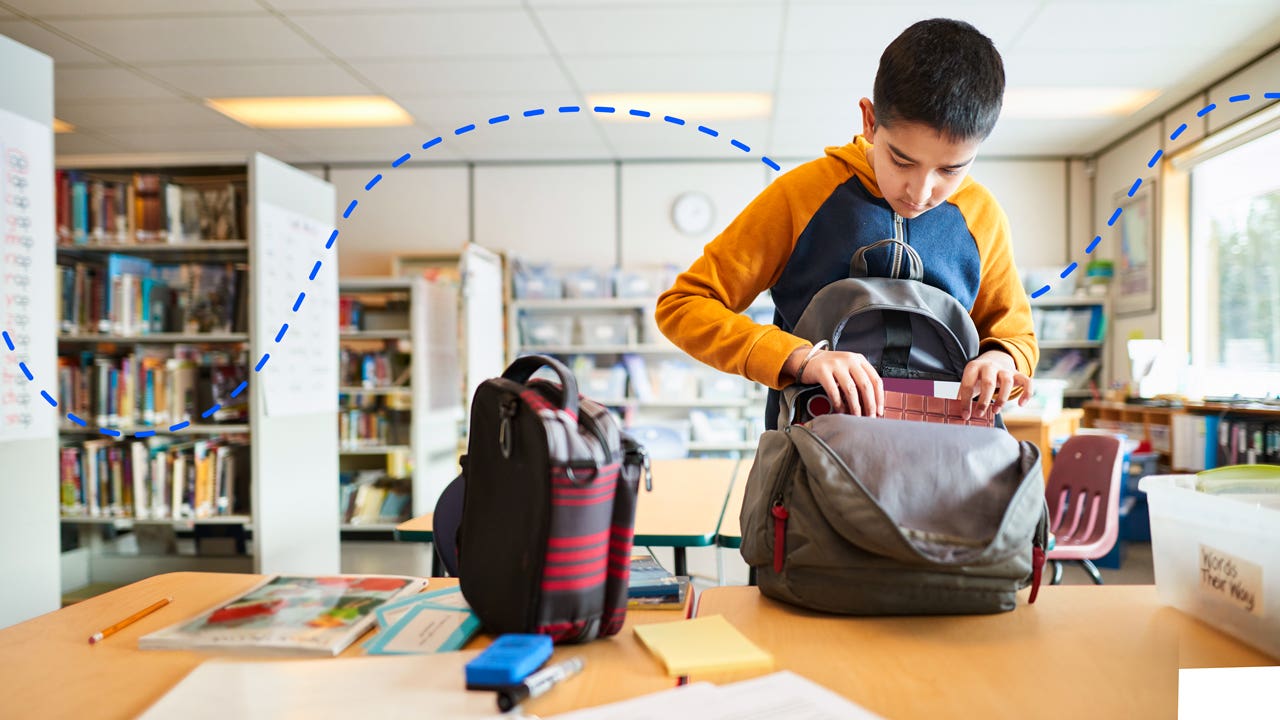41% of back-to-school shoppers will change how they shop due to inflation

The Bankrate promise
At Bankrate we strive to help you make smarter financial decisions. While we adhere to strict , this post may contain references to products from our partners. Here's an explanation for . The content on this page is accurate as of the posting date; however, some of the offers mentioned may have expired. Terms apply to the offers listed on this page. Any opinions, analyses, reviews or recommendations expressed in this article are those of the author’s alone, and have not been reviewed, approved or otherwise endorsed by any card issuer.
There’s no disputing the impact historic inflation rates are having on U.S. consumers. In the twelve months ending in June 2022, the cost of goods and services soared by 9.1 percent. Such price jumps have put extreme pressure on consumers, especially families preparing for the upcoming school year.
A new back-to-school shopping survey conducted by Bankrate found 41 percent of back-to-school shoppers say inflation will alter their shopping habits for the upcoming school year. Of this group, a remarkable 95 percent are exploring money-saving strategies.
Ready for a back-to-school shopping plan that works for you? Here’s what others are doing and how you can best manage the upcoming expenses.
Middle-income earners prepare for the greatest changes
Though nearly everyone in the U.S. is feeling the financial pinch, middle-income consumers are making those back-to-school shopping adjustments at the highest rate: 53 percent of those with annual household incomes between $50,000 and $99,999 per year say they will be changing their spending because of inflation. That’s compared with 39 percent of higher-income households (earning $100,000 or more annually) and 37 percent of lower-income households (earning less than $50,000 annually).
Middle-income households are also more likely to use money-saving tactics like obtaining more used/secondhand items (28 percent vs. 21 percent of lower-income households and 23 percent of higher-income households), stretching current items another year (32 percent vs. 28 percent of lower-income and higher-income households) and seeking out more coupons, discounts and sales (50 percent vs. 46 percent of lower-income households and 43 percent of higher-income households).
Shoppers seek savings
If you’re like most Americans, shopping for school expenses is a major retail event. According to the National Retail Federation’s annual survey, families with children in elementary through high school plan to spend an average of $864 on school items this year.
Trying to cover those costs is taking a major financial toll on American families who are already struggling to manage more expensive household line items. Bankrate’s survey found that 31 percent of back-to-school shoppers expect these purchases will strain their budgets, and 26 percent say they feel pressured to spend more than they’re comfortable with.
Such financial stress is no surprise, considering the higher costs consumers are facing. A February 2022 survey from Bankrate found that 93 percent of Americans have experienced higher prices over the past year, and almost 3 in 4 (73 percent) were worried about new or continued price increases on everyday essentials over the next year.
Thankfully, there are feasible ways to stretch your dollars. Bankrate’s survey found inflation-conscious back-to-school shoppers are planning on taking action to offset higher costs:
- 54 percent plan to seek more coupons, discounts and sales.
- 45 percent plan to buy fewer school items (supplies, clothes, etc.).
- 43 percent plan to shop cheaper brands.
- 39 percent plan to stretch the items they currently have for another year.
- 37 percent plan to shop at stores where they have loyalty accounts or store-specific credit cards.
- 30 percent plan to obtain used and secondhand items.
- 25 percent plan to use credit card rewards to offset costs.
- 21 percent plan to delay purchases.
- 4 percent plan to employ another cost-saving technique.
“I think all of the money-saving strategies referenced in our survey are worth considering,” says Bankrate senior industry analyst Ted Rossman. “I’m especially fond of looking for opportunities to stack discounts, for example, combining credit card rewards with store coupons and online shopping portals. That represents three ways to save on the same purchase.”
How consumers are financing back to school
So how will shoppers pay for their hauls? Of those who plan to back-to-school shop this year, more than half (57 percent) will use a debit card to pay for these purchases, followed by cash (47 percent) and a credit card (46 percent). Less common payment options include buy now pay later services (14 percent) and checks (9 percent).
Credit card users vary in how they will pay off their back-to-school shopping: 30 percent plan to pay in full on their statement date, and 21 percent plan to split up payments over several billing cycles.
Keeping debt to a minimum is important, however, particularly as inflation rages on. Credit card balances are trending upwards as people attempt to close financial shortfalls. The Federal Reserve Bank of New York’s August 2022 household debt and credit report identified a 13 percent year-over-year uptick in credit card balances, the largest increase in 20 years. With credit card interest rates also rising, the fees involved in carrying a credit card balance from one month to the next can heighten rather than alleviate financial stress.
Although using cash for purchases, including paying a credit card bill in full, is a good way to avoid interest, the survey found only 33 percent of the back-to-school shoppers expect to have money expressly set aside for these purchases.
Use the right credit cards for back-to-school shopping
In addition to prudent spending strategies, back-to-school shoppers can cut costs and steer clear of expensive credit card debt by using the right payment products.
Rewards credit cards are excellent tools. You can use a cash back card to accumulate money as you charge the back-to-school expenses, and then use the cash you earned to either pay the bill or to buy other necessary items. Credit cards that offer rewards in points can also be beneficial. Most issuers allow cardholders to redeem points for cash or gift cards, and if there is a shopping portal, you can trade the rewards for products.
Applying for a new credit card can also help. Look for credit cards with large sign-up bonuses. The best credit card sign-up bonuses can give you several hundred dollars of cash or points you can put toward your shopping needs, thus reducing your outlay.
Another option is a credit card with a 0 percent intro APR. These are great products if you need to pay off your back-to-school expenses over time. The best 0 percent intro APR offers give you more than a year to repay the balance without additional financing fees. Just be sure to pay the balance completely before the regular rate goes into effect.
The bottom line
No one knows when inflation will ease and costs will go down, or even stabilize. Although prices on consumer goods are out of your control, the way you shop and pay for back-to-school items is one thing you can control. Use spending strategies that make sense for you and your family. Whenever possible, delete consumer debt before interest applies, and use credit cards so they work for — rather than against — you.
Methodology
Bankrate.com commissioned YouGov Plc to conduct the survey. All figures, unless otherwise stated, are from YouGov Plc. The total sample size was 2,438 adults, among whom 729 plan to go for back-to-school shopping. Fieldwork was undertaken between July 13-15, 2022. The survey was carried out online and meets rigorous quality standards. It employed a nonprobability-based sample using quotas upfront during collection and then a weighting scheme on the back end designed and proven to provide nationally representative results.
Related Articles

Survey: More than half of economists say surging inflation will climb much higher than expected

Top high-yield savings accounts are now beating inflation. Here’s why that’s important

What is inflation? Here’s how rising prices can erode your purchasing power
